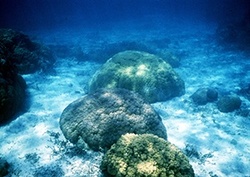A study of fossilized corals suggests that changes in the North Atlantic during the last deglaciation profoundly affected the climate of the tropical South Pacific

Fig. 1: Ancient Porites corals act as useful indicators of past climate.
The last Ice Age ended approximately 20,000 years ago when the ice sheets that covered much of the Northern Hemisphere began to recede. However, the general warming trend that melted the ice was punctuated by transitory cooling and warming events that probably affected ocean circulation around the globe. A team including Yasufumi Iryu from Nagoya University has now reconstructed sea-surface conditions in the tropical South Pacific Ocean towards the end of the last Ice Age using fossil corals1.
"Unraveling how the climate of the tropical South Pacific responded to changes in the Northern Hemisphere is important for understanding the Earth's climate system," says Iryu. He and his co-workers looked for clues in massive Porites corals (Fig. 1), which live in shallow tropical and subtropical waters and have stony skeletons consisting of the carbonate mineral aragonite. "The aragonite skeletons have annual growth bands rather like tree rings that allow us to discern changes in growth conditions each year," says Iryu.
Using modern geochemical techniques, the researchers analyzed two well-preserved fossil coral samples drilled from the seabed off the island of Tahiti during an expedition of the Integrated Ocean Drilling Program.
One of the coral samples was around 14,200 years old, corresponding to an episode of warming known as the Bolling-Allerod period when the great Laurentide Ice Sheet that covered most of the North American continent receded and sea levels rose as vast amounts of fresh meltwater entered the North Atlantic. The other sample was around 12,400 years old, a time corresponding to the Younger Dryas stadial -- the so-called 'Big Freeze' that brought an abrupt end to the Bolling-Allerod warming.
Using established methods based on measurements of calcium, strontium and oxygen isotopes in the fossil corals, the researchers reconstructed the ocean conditions prevailing when the corals were alive. Their analyses indicate that the annual mean sea surface temperature (SST) in the central tropical South Pacific was 2.6-3.1 °C cooler 12,400 years ago than today, and 1.0-1.6 °C cooler 14,200 years ago. The researchers found no evidence for significant changes in the amplitude of the SST seasonal cycle, but noted that the surface waters were more saline during these cooler periods than they are now.
"Our findings substantiate previously published results that suggested pronounced Younger Dryas cooling of tropical South Pacific waters," says Iryu. "We now need to decipher the physical mechanisms linking the North Atlantic and tropical Pacific Oceans during the last deglaciation."
Affiliated Researchers
The Nagoya University affiliated researchers mentioned in this highlight are from the From Earth System Science to Basic and Clinical Environmental Studies GCOE program
Reference
- Asami, R. et al. Evidence for tropical South Pacific climate change during the Younger Dryas and the Bolling-Allerod from geochemical records of fossil Tahiti corals. Earth and Planetary Science Letters 288, 96-107 (2009). | article